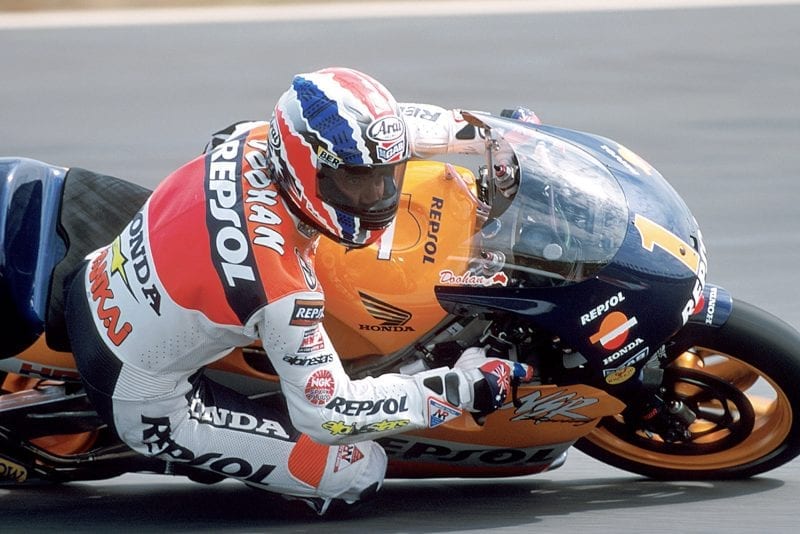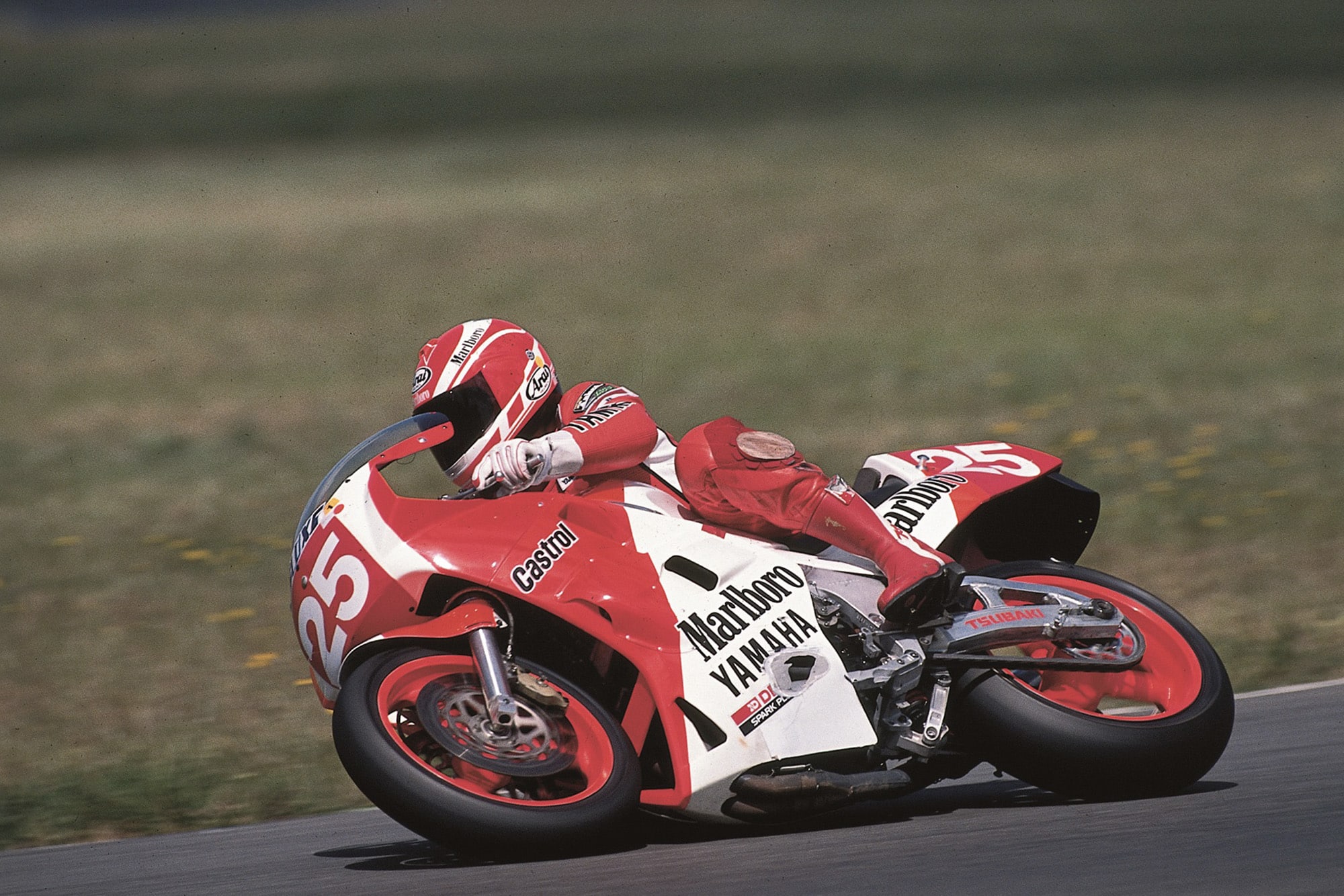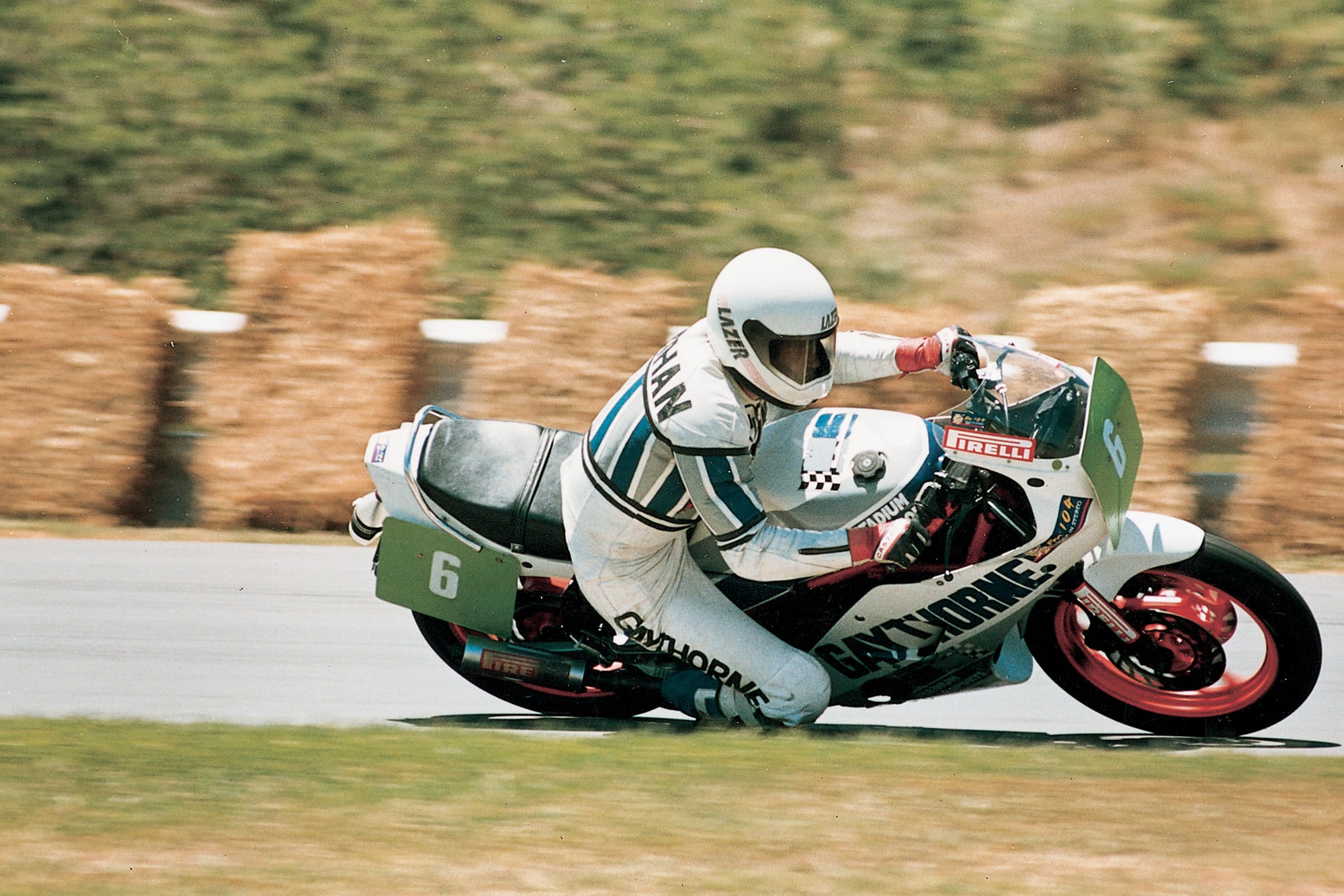Mick Doohan: How I rode
The teak-tough Aussie was the most successful 500 two-stroke rider of all time. This is how Mick Doohan did it

Doohan aboard Honda's NSR500
Alpinestars
Mick Doohan raced 500 GPs from 1989 to 1999, during which time the 500 two-strokes evolved from truly malevolent machines to mostly rider-friendly missiles.
His debut season, aboard Honda’s vicious 1989 NSR500, was marred by injury. So too was what should’ve been his first championship-winning season, in 1992. Doohan nearly lost his right leg following an accident at that year’s Dutch TT, but fought back from that to win five consecutive 500 titles from 1994 to 1998. He retired injured, during the 1999 season, just like rivals Wayne Rainey and Kevin Schwantz before him. As Doohan says, “I didn’t crash much, but when I did I did it properly”.
You had a very rapid rise – from 250 proddie bikes in 1987 to superbikes in 1988 to 500s in 1989 – how did you adjust?
Going from proddie bikes to the superbike, the superbike felt easier.
What about the 500s? Because the first 500 you rode was Yamaha’s YZR, when they were trying to sign you at the end of 1988…
I only rode the Yamaha 500 once and went quite well on it. To me it felt like every other Yamaha I’d ridden – you looked one way and the bike went that way. It had some throttle lag, almost like a dead spot, so you had to crack the throttle a bit to get the thing ticking over before you could really open it up. Whereas the Honda’s carburation was very connected – you’d open the throttle and it was there instantly, so the load would transfer straight to the rear tyre and the thing would spin up that easy. I preferred having a bit of lag.
When I first hopped on the Honda it threw me down pretty quick. That was the ’88 bike, after I’d tested the Yamaha. Then I hopped on the ’89 bike, which did similar things. I was thinking, ‘Jesus, have I signed for the right manufacturer?!’
I had to dig deep to not just give up and go back to superbikes. At certain points I thought, ‘I can’t ride one of these things’, especially with the likes of [Eddie] Lawson, Rainey and Schwantz, who were a fair bit up the road from me. Equally, I never gave up believing that I could do it.
There were a few crashes! The ’89 NSR didn’t have any feel, that was what I wasn’t used to. Basically you couldn’t feel the front and you could hardly feel the rear. You’d put the bike on its side in the corner and it didn’t turn, it’d still go straight. So then you’d try to pull it back, but you couldn’t feel the front sliding, so the next moment you were either down or the rear was coming around on you as you tried to pull the bike back.
It was a very strange bike to get to understand. There were glimmers of hope occasionally – you’d do a good lap here and there. That told me I can put it together, I just needed to understand the bike more.
It was all about persistence and understanding what you needed to do with the bike. Thankfully Lawson was with HRC in ’89 and he’d come from Yamaha; plus [HRC’s 1987 champion Wayne] Gardner went out early in the season [after breaking a leg at Laguna Seca], so the development went Lawson’s way. Equally, my feedback, even though I was very green, was similar to his. I was wanting a Yamaha and he was wanting a Yamaha.

Doohan scraping a Yamaha FZR750 superbike to bits in 1988 Photo: Yamaha
That’s when HRC started making forward strides…
That’s right. I think there were 15 GPs in ’89 and Lawson had 11 different chassis for his bike, while I finished the year with chassis number four. At the end of the season Lawson signed straight back to Yamaha and then Honda started following my lead, so I kept that development lane going.
Back then we were used to seeing Schwantz and Rainey spinning the rear, but we’d never seen anyone push the front as hard as you. How did you learn to do that?
By landing on my head a few times! To be honest, it just felt comfortable to me. I wish I had some magic formula, but pushing the front never concerned me.
Australian dirt track is different to U.S. dirt track. They are oiled dirt tracks and you’re going left and right, putting the bike in there, so the front is sliding around on the way in, then you’ve got to turn back on yourself, with the rear sliding around.
Maybe that was the reason for my style on the 500. I’d have my backside and lower body well off the bike, pushing the bike, so I could flick it from side to side. That was especially true in left-handers. My style was a little more traditional in right-handers, but the lower half of my body was still well off the bike.
I was dicking around on the last lap at Le Mans in ’94 and I was lighting up the rear. It started to go. That was a bit of a wake-up call – don’t get too cocky, you know?
Once I had good feel from the front I didn’t care what the rear was doing. It could move around as much as it wanted, so long as I had some feedback from the front, which is what I didn’t have with the ’89 NSR. The rear sliding wasn’t an issue for me at all, except when it snapped out too quick and you couldn’t catch it.
The ’90 bike gave me a little bit more feel, then we modified it some more during the season. We raised the steering head to give me a little different geometry, which gave me so much more feel. Then we raised the engine up, which gave us even more feel. The bike became a bit harder to get from side to side, but once it was in the turn it turned. Gardner wanted his bike different, so he had a different chassis with the engine lower.
You used the clutch more than the throttle to control wheelspin – tell us how that worked.
Once a two-stroke has got a gutful of fuel, rolling the throttle off won’t do anything, because it’s going to burn that fuel, so the engine is still going to spin the tyre.
The clutch would instantly disengage the engine, so if it was getting too aggressive you could use the clutch to pull out some of the spin, because you knew that rolling out the throttle would be too slow. Normally you’d just feather the clutch, but sometimes if the rear was going too quick you’d pull it in real quick.
One moment springs to mind – I was dicking around on the last lap at Le Mans in ’94. I was coming through the last left before the last double right and I was lighting up the rear. It started to go and I had to grab a handful of clutch, otherwise it was going to flick me. That was a bit of a wake-up call – don’t get too cocky, you know? Without the clutch that would’ve been a crash.
How did you work out the clutch/traction-control thing?
I don’t know. I probably did it a bit in dirt track – you were always playing with the clutch in dirt track.
The clutch wasn’t only your traction control, it was also your slipper clutch and engine-braking control…
When we ran four-strokes in the Suzuka 8 Hours the bikes didn’t have a slipper clutch, so you disengaged the clutch so you could run straight into corners as hard as you could. You’d hit the brakes, pull in the clutch, do all the backshifts, go through the corner, then when you were slowed up enough so the rear wouldn’t come around, you slowly let out the clutch as you got back on the throttle.
The clutch was an important part of the bike. I rode [Casey] Stoner’s bike a few years ago at Phillip Island. I was on the clutch a lot, so the HRC guys were freaking out because I was confusing the computer!

Doohan and his Yamaha RD250LC in 1987 Photo: Doohan Archive
How did the 500s change when HRC came up with its big-bang engine in 1992?
The bikes were still the same because they’d still spin up as much, but the big bang had the perception of having more torque and a bit more predictability. It was a bit more user-friendly. You’d give it some gas and it wouldn’t react to the tyre wheel so badly.
It always seemed to me that you were the guy that made the 500s rideable for the Europeans…
I think I made them rideable for me!
You rode the front tyre so hard that Michelin had to make a better tyre. And, although the big bang wasn’t your idea, you were always asking for a more useable engine. With a better front tyre and a user-friendly engine the 500s became rideable for former 125 and 250 riders, so the factories no longer had to hire former dirt trackers…
I’d like to say that it was all me but I doubt that’s the case. It was just evolution of all the chassis engineering – suspension, tyres and so on – it was a combination of all of that. And all the manufacturers were getting better at making the engines more tractable. Like when I went back to the screamer engine in ’97 it wasn’t anywhere near as aggressive as the ’91 screamer engine. The porting, the electronics and everything else had all changed
Riding the screamer in ’97 gave me a mental advantage. The performance of the bike was exactly the same as the big bang. It was just that when the other guys tried the screamer they were getting flicked off and scaring the shit out of themselves. They were used to being more aggressive with the throttle with the big bang, whereas with the screamer you still needed to be a little smoother on the throttle. So all that was a mental boost for me.
I didn’t have the strength to flick the bike right though the Corkscrew, so I went through the left and flicked the bike too hard with my upper body, which picked the bike up, flicked it around and flicked me off
You were always big on the mental stuff…
You needed something, because everyone was on a fricking Honda! When Rainey got injured [at Misano in September 1993] he was leading the world championship and Yamaha were running one/two in that race, so there wasn’t anything wrong with the bike. Then all of a sudden the Yamaha couldn’t win a race anymore. It was just that everyone had given up hope. I was winning on the Honda, so everyone was, like, we need a Honda if we want to win.
That didn’t faze me, because I’ve got to beat you no matter what you’re on. I think all the manufacturers were building good bikes – Yamaha had a good chassis and so did Suzuki. But I don’t know if the big bang was as much as an advantage to Yamaha and Suzuki as it was to Honda, because the Honda engine had always been a bit more aggressive.
You were talking about body position. When you came back from your leg injury you couldn’t use your lower body, because the leg was too weak, so you had to use your upper body, which caused more crashes…
Steering the bike with your feet was the only way back then and I’m sure it’s much the same today. But after I got injured I couldn’t do that and I crashed a few times because of that.
During testing in ’93 I crashed at Eastern Creek. The front folded going into a corner and by the time I’d got off the throttle the bike came around on me and flicked me. I broke something in that one. I can’t remember what, but it certainly didn’t help the recovery.
Then at the end of ’93 I was leading the race at Laguna and the same thing happened. I was still flicking the bike with my upper body instead of my lower body because my right leg was essentially still broken, and flexing.
I didn’t have the strength to flick the bike right though the Corkscrew, so I went through the left and flicked the bike too hard with my upper body, which picked the bike up, flicked it around and flicked me off.
I did things to help me in braking too. I got Alpinestars to put heels on my boots to help me stop the bike. I’d hook the heels in on the footrests, so I could use my lower body to help me brake, rather than all the forces going through my arms.
Moving forward a bit, you weren’t happy when unleaded fuel was introduced in 1998…
For sure that helped the European riders, the non-dirt track riders, because it softened the power. All of a sudden the 500 became a big 250, which I wasn’t used to, because I’d never ridden a 250 GP bike. So I had to relearn the 500 a bit because I had to carry corner speed, whereas before you couldn’t open the throttle with any lean angle, because there wasn’t any side-grip, so it’d just spin the tyre. Before unleaded fuel you went into a corner, laid the bike on its side, then you picked it up and got it out of there, so the cornering line was more of a V shape. When they brought in unleaded fuel that was the first year you could start riding the 500s with corner speed.
How long did it take you to work that out?
Not too long, but it was a wake-up call.
What did you most enjoy about riding 500s?
Just the pure adrenaline you got from trying to ride the 500 to the maximum, of my ability, anyway. That was fairly rewarding because it was knife-edge. You could feel when everything was together – the bike was just floating on the asphalt, with the rear wheel spinning slightly and the front wheel just off the ground. Just that sensation of the whole thing dancing around underneath you, that was what was exciting. Then, of course, there was the competition. But it was so rewarding riding one of those things at the edge.
Salzburgring was one of the most dangerous tracks back then, and your favourite corner was the most dangerous corner at Salzburgring!
That highlights what I was saying. Salzburgring was a daunting place, for sure. You came up the hill with the mountain on one side, right by the edge of the track, and Armco on the other, right by the track. It was top gear coming up through there, and top speed at Salzburgring was around 310, 312 kays [193mph], something like that. It was almost like you were in a bit of a tunnel and the bike was doing its own thing and you were trying to direct it where to go. That made it exciting.
You’d be cresting the top of the hill as you changed direction from left to right, so the bike got light and it’d get a little crossed up. So the bike’s close to getting air through there and wanting to go that way, but you’re trying to get it to go the other way, so it’s almost sliding in the opposite direction to where you want it to go, so you’re having to flip it around. That sensation – the bike was truly dancing around. Plus, you knew you couldn’t crash there.

